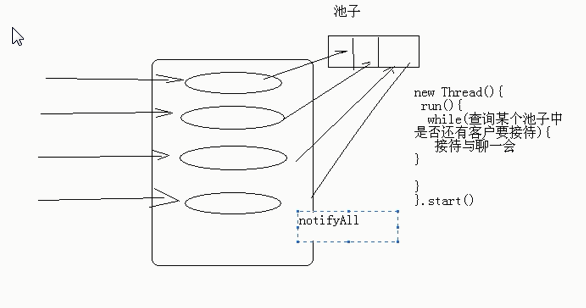线程池
线程池的思想

线程池的概念与Executors类的应用
> 创建固定大小的线程池
> 创建缓存线程池
> 创建单一线程池(如何实现线程死掉后重新启动?)
关闭线程池
> shutdown 与 shutdownNow的比较
用线程池启动定时器
> 调用ScheduleExecutorService 的 schedule 方法,返回的ScheduleFuture对象可以取消任务。
> 支持间隔重复任务的定时方式,不直接支持决定定时的方法,需要转换成相对时间方式。
public class ThreadPoolTest { public static void main(String[] args) { // ExecutorService threadPool = Executors.newFixedThreadPool(3); //创建一个固定大小的线程池,线程池中有3个线程可以同时服务 //缓存线程池 线程池中的线程数是动态变化的,当所有线程处于服务状态时,还有需要被服务的任务,自动增加一个线程进行服务 //当任务执行完毕,线程处于空闲一段时间,超时后则自动回收销毁线程 // ExecutorService threadPool = Executors.newCachedThreadPool(); //创建一个只有一个线程的线程池,当这个线程挂掉时,可以自动生成一个线程来代替 //可以解决一个网上很多人问的问题(如何实现线程死掉后重新启动?) ExecutorService threadPool = Executors.newSingleThreadExecutor(); for(int i = 0;i<10;i++){ //往线程池中扔10个任务 final int task = i; threadPool.execute(new Runnable() { //往线程池中扔了一个任务 @Override public void run() { for(int j = 0;j<10;j++){ System.out.println(Thread.currentThread().getName()+" is loop of "+ j + "the task of "+task); } } }); } System.out.println("all of 10 tasks have committed"); //上述代码执行完后 没有结束,线程池中有3个线程一直存在,所以程序不会结束 //可以使用 threadPool.shutdown() threadPool.shutdown(); //当线程池中线程执行完所有任务,所有线程处于空闲状态时,干掉所有线程,程序自结束 // threadPool.shutdownNow(); //立即把池子中所有线程干掉,无论任务是否干完 } }
package com.java.juc; import java.util.concurrent.ExecutorService; import java.util.concurrent.Executors; /** * 一、线程池:提供了一个线程队列,队列中保存着所有等待状态的线程。避免了创建与销毁额外的开销,提高了响应的速度。 * * 二、线程池的体系结构: * java.util.concurrent.Executor: 负责线程的使用与调度根接口。 * |--**ExecutorService 子接口:线程池的主要接口 * |--ThreadPoolExecutor 线程池的实现类 * |--ScheduledExecutorService 子接口:负责线程的调度 * |--ScheduledThreadPoolExecutor : 继承 ThreadPoolExecutor 实现ScheduledExecutorService * 三、工具类:Executors * ExecutorService newFixedThreadPool() :创建固定大小的线程池。 * ExecutorService newCachedThreadPool(): 创建无限大小的线程池,线程池中线程数量不固定,可根据需求自动更改。 * ExecutorService newSingleThreadPool() : 创建单个线程池,线程池中只有一个线程。 * * ScheduledExecutorService newScheduledThreadPool() 创建固定大小的线程池,可以延迟或定时的执行任务。 * */ public class TestThreadPool { public static void main(String[] args) { //1.创建线程池 ExecutorService threadPool = Executors.newFixedThreadPool(5); ThreadPoolDemo demo = new ThreadPoolDemo(); //2.为线程池中的线程分配任务 for(int i = 0;i<10;i++){ threadPool.submit(demo); } //3.关闭线程池 threadPool.shutdown(); //等待现有线程池中的任务之心完毕,关闭线程池,在等待过程中不接收新的任务 } } class ThreadPoolDemo implements Runnable{ private int i = 0; @Override public void run() { while(i <= 100){ System.out.println(Thread.currentThread().getName() + " : " + i++); } } }
可以在线程池中放一个Callable任务,并且可以过去到返回结果
package com.java.juc; import java.util.ArrayList; import java.util.List; import java.util.concurrent.Callable; import java.util.concurrent.ExecutionException; import java.util.concurrent.ExecutorService; import java.util.concurrent.Executors; import java.util.concurrent.Future; /** * 一、线程池:提供了一个线程队列,队列中保存着所有等待状态的线程。避免了创建与销毁额外的开销,提高了响应的速度。 * * 二、线程池的体系结构: * java.util.concurrent.Executor: 负责线程的使用与调度根接口。 * |--**ExecutorService 子接口:线程池的主要接口 * |--ThreadPoolExecutor 线程池的实现类 * |--ScheduledExecutorService 子接口:负责线程的调度 * |--ScheduledThreadPoolExecutor : 继承 ThreadPoolExecutor 实现ScheduledExecutorService * 三、工具类:Executors * ExecutorService newFixedThreadPool() :创建固定大小的线程池。 * ExecutorService newCachedThreadPool(): 创建无限大小的线程池,线程池中线程数量不固定,可根据需求自动更改。 * ExecutorService newSingleThreadPool() : 创建单个线程池,线程池中只有一个线程。 * * ScheduledExecutorService newScheduledThreadPool() 创建固定大小的线程池,可以延迟或定时的执行任务。 * */ public class TestThreadPool { public static void main(String[] args) throws InterruptedException, ExecutionException { //1.创建线程池 ExecutorService threadPool = Executors.newFixedThreadPool(5); ThreadPoolDemo demo = new ThreadPoolDemo(); List<Future> futureList = new ArrayList<>(); for(int i = 0; i<10; i++){ Future<Integer> future = threadPool.submit(new Callable<Integer>() { public Integer call(){ int num = 0; for(int i = 0;i<=100;i++){ num+=i; } return num; } }); futureList.add(future); } for(int i = 0;i<futureList.size();i++){ System.out.println(futureList.get(i).get()); } // //2.为线程池中的线程分配任务 // for(int i = 0;i<10;i++){ // threadPool.submit(demo); // } //3.关闭线程池 threadPool.shutdown(); //等待现有线程池中的任务之心完毕,关闭线程池,在等待过程中不接收新的任务 } } class ThreadPoolDemo implements Runnable{ private int i = 0; @Override public void run() { while(i <= 100){ System.out.println(Thread.currentThread().getName() + " : " + i++); } } }
5050
5050
5050
5050
5050
5050
5050
5050
5050
5050
用线程池启动定时器
Executors.newScheduledThreadPool(3).schedule( new Runnable() { @Override public void run() { System.out.println("bombing!"); } }, 10, TimeUnit.SECONDS);
还可以在上述代码中添加固定频率
//固定频率 10秒后触发,每隔两秒后执行一次 Executors.newScheduledThreadPool(3).scheduleAtFixedRate( new Runnable() { @Override public void run() { System.out.println("bombing!"); } }, 10, 2, TimeUnit.SECONDS); //在使用scheduleAtFixedRate 时java api没有提供在某个时间点触发,但API中提示可以通过计算,得到触发的事件点 // For example, to schedule at a certain future date, // you can use: schedule(task, date.getTime() - System.currentTimeMillis(), TimeUnit.MILLISECONDS).